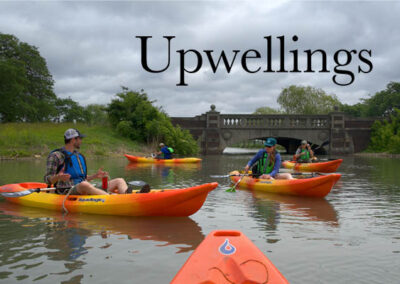It doesn’t make for sensational headlines, but charter fishing has been a consistent part of coastal tourism despite recent ups and downs in fishing success.

Unhooking a Chinook salmon on the deck of a Lake Michigan charter boat. Lake Michigan charter trips and salmon remain a big draw and consistent part of coastal tourism. Photo: Michigan Sea Grant
For the past 10 years as a Sea Grant Extension Educator I’ve worked to understand the economic impact of Michigan’s charter boat industry. This has big implications for coastal tourism. In 2016, charter fishing generated $23 million in Michigan’s coastal communities, resulting in 476,361 employment hours. Lake Michigan’s charter fishery is the largest, accounting for around 70 percent of the state’s charter fishing effort according to Michigan DNR. Charter captains in Michigan report their catch and effort to DNR, and Michigan Sea Grant uses this information to calculate economic impacts and investigate trends.
Big salmon are a big draw
Last year was a tough one for fishing. The Chinook salmon is a prized species on Lake Michigan, and charter harvest rate of Chinook salmon fell to the lowest it has been since 1995, when bacterial kidney disease (BKD) wiped out many of the lake’s salmon. According to Michigan DNR, charter harvest in Michigan waters of Lake Michigan ranged from 1.09 to 1.94 Chinook salmon per trip in the early 1990s, ranged from 2.24 to 7.40/trip 1996-2014, and fell from 2.27/trip in 2015 to 1.94/trip in 2016.
This understandably caused a lot of concern among charter captains last year. Angst was compounded by plans to reduce stocking, although the goal of the stocking cut was to prevent a complete crash in the fishery. Some of the debate centered on which species to cut: lake trout or Chinook salmon.
A recent study funded by Wisconsin Sea Grant found that Wisconsin anglers on Lake Michigan are willing to pay more to target Chinook salmon ($140/trip) vs. lake trout ($90/trip). An earlier study on the Lake Huron charter fishery found that the decline of Chinook salmon catch rates was linked to a 51 percent drop in charter fishing effort and resulting economic impacts, although increasing gas prices in the late 2000s were also a factor. During the Lake Huron charter fishing crash of the mid-2000s lake trout catch rates remained high. But what does this all mean for Michigan waters of Lake Michigan?
Consistent economic impacts are the rule
Despite low Chinook salmon catch rates in 2015 and 2016, charter trips and resulting economic impacts did not exhibit the same kind of crash that occurred in Lake Huron around 2004. In fact, Lake Michigan charter trips remained above the post-BKD average of 11,577 trips/year in 2015 and 2016 according to Michigan DNR.
A 2009 charter economic study found that the economic impact of charter fishing around Lake Michigan averaged $14 million; due to economic factors (e.g., rising gas prices, recession) this fell to $11.6 million in 2009. After adjusting for inflation, this means that Lake Michigan charter fishing generated an average of $15.7 million in Michigan and bottomed out at $12.6 million in 2009. In 2016, Michigan Sea Grant found that Lake Michigan charter fishing generated $15.7 million in economic impacts for Michigan coastal communities. Dead on average, despite the low Chinook salmon harvest rate.
Few fluctuations relative to Huron
The fact of the matter is that Lake Michigan’s charter fishery has been much less volatile than Lake Huron’s, both in terms of harvest rates and economic impacts. While Lake Michigan harvest rate dropped to just under two Chinook salmon per trip in 2016, Lake Huron crashed to fewer than one Chinook salmon every two trips (Michigan DNR data) and economic impacts of charter fishing fell by more than 50 percent.
In other words, anglers could still expect a good chance that their boat would harvest a Chinook on Lake Michigan last year while this was not the case after the decline of salmon on Lake Huron. Other species (including lake trout, coho salmon, and steelhead) play an important role in the charter fishery, too. Many anglers are thrilled to catch any of our Great Lakes trout and salmon, all of which make good eating and top out at an impressive size.
Given the recent troubles with predator-prey balance in Lake Michigan and the high prey consumption of Chinook salmon, we can expect a more diverse mix of predators in the future along with modest Chinook catch rates. The good news is that the economic impacts of Lake Michigan’s charter fishery appear to be quite stable so long as anglers can still expect a reasonable chance at boating a ‘king.’


